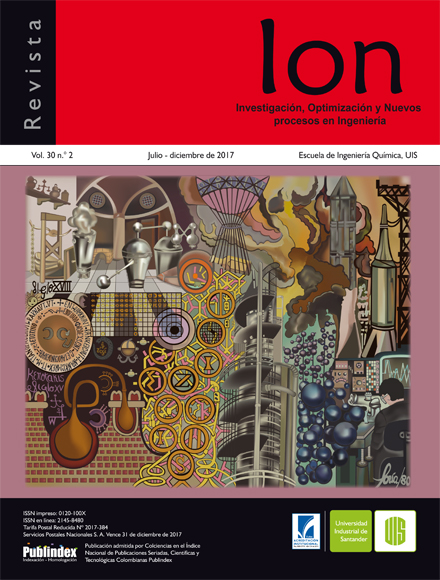Obtaining and evaluation of enzymatic extract from Aspergillus spp. by saccharification of sour cassava starch liqued
Published 2018-05-06
Keywords
- Glucoamylase,
- Aspergillus,
- Saccharification,
- Syrup Glucose
How to Cite
Copyright (c) 2018 Revista ion

This work is licensed under a Creative Commons Attribution 4.0 International License.
Abstract
The saccharification enzymes are more expensive than liquefaction enzymes for that reason are sought strategies that allow the supply of these enzymes at low cost. The objectives of this study were to evolve saccharolytic enzymatic extracts from native strains, to select an extract and to determine the best variables for the production of glucose syrups from liquefied bitter cassava starch.Thirteen mushrooms isolated from sour cassava (Manihot sp). were evaluated for their saccharolytic activity, hydrolysis of maltose, glucose production and biomass formation in submerged fermentation. Aspergillus A1 was selected because it had the highest volumetric activity (0.09UI.L-1). During solid-state fermentation, the presence of proteins was corroborated by electrophoresis SDS-PAGE. Through various experiments, the best experimental condition were pH 4.0, agitation 0r.p.m and temperature 55.0°C; the effect of cofactors Cu2+, K+, Mg2+ and Na+ was evaluated, Mg2+ increases the activity in 1.32UImg-1 (32.4%). The thermal stability at 55.0°C is 120 minutes. Finally, the saccharolytic capacity of the enzymatic extract was confirmed using liquefied cassava starch.
Downloads
References
[2] Sorapipatana C, Yoosin S. Life cycle cost of ethanol production from cassava in Thailand. Renew sust energ rev. 2011;15:1343–9.
[3] Shanavas S, Padmaja G, Moorthy S, Sajeev M, Sheriff J. Process optimization for bioethanol production from cassava starch using novel eco-friendly enzymes. Biomass Bioenerg. 2001;35:901–9.
[4] Hebeda R. Enzymes in Food Processing, 3 ed. San Diego, USA. Academic press; 1993.
[5] Johnson R, Padmaja G, Moorthy S. Comparative production of glucose and high fructose syrup from cassava and sweet potato roots by direct conversion techniques Innov. Food Sci. Emerg. Technol. 2009;10:616–20.
[6] Bertoldo C, Antranikian G. Starch-hydrolyzing enzymes from thermophilic archaea and bacteria. Curr Opin Chem Biol. 2002;6:151–60.
[7] Klanarong S, Kuakoon P, Sittichoke W, Siriluck N. The promise of a technology revolution in cassava bioethanol: from thai practice to the world practice Fuel. 2010;89:1333–8.
[8] Leveque E, Janecekc S, Hayea B, Belarbid A. Thermophilic archaeal amylolytic enzymes. Enzyme Microb. Technol. 2000;26:3–14.
[9] Sánchez C, Mejia C, Figueroa C, Esquivia M, Agudelo L, Zatapata N. Biospropección de microorganismos nativos amilolíticos. Vitae. 2004;2:8-17.
[10] Norouzian D, Akbarzadeh A, Scharer J, Young M. Fungal glucoamylases Biotechnol. Adv. 2006;24:80–5.
[11] Saldarriaga Y, Pineda F. Manual de Micología Aplicada, 1 ed. Medellin, Colombia. Universidad de Antioquia, 2001.
[12] Miller G. Use of DinitrosaIicyIic Acid Reagent for Determination of Reducing Sugar Anal Chem. 1959;31:426–8.
[13] Biosystems. Glucose oxidase protocol. Avaible in: http://www.biosystems.es/products/CLINICAL%20DIAGNOSTICS/Biochemistry/A U TO M AT E D % 2 0 S Y S T E M S / G l u c o s e /GLUCOSE-OXIDASE.
[14] Bradford M. A Rapid and sensitive method for the quantitation of microgram quantities of protein utilizing the principle of protein-dye binding Anal Biochem. 1974;72:248-54.
[15] Bhatti H, Rashid M, Nawaz R. Purification and characterization of a novel glucoamylase from Fusarium solani. Food Chem. 2007;103:338–43.
[16] Ruiz M, Sanchez C, Torrres R, Molina D. Enzymatic Hydrolysis of Cassava starch for production of bioethanol with a colombian wild yeast strain J. Braz. Chem. Soc. 2001;2:2337–43.
[17] Buchholz K, Seibel J. Industrial carbohydrate biotransformations Carbohyd. Res. 2008;343:1966–79.
[18] Wang Q, Wang X, Wang X, Ma H. Glucoamylase production from food waste by Aspergillus niger under submerged fermentation Process Biochem. 2007;43:280–6.
[19] Riaz M, Perveen R, Javed M, Nadeem H, Rashid M. Kinetic and thermodynamic properties of novel glucoamylase from Humicola sp. Enzyme Microb. Technol. 2007;41:558–64.
[20] O’Brien S, Wang Y. Susceptibility of annealed starches to hydrolysis by α-amylase and glucoamylase. Carbohyd. Polym. 2008;72:597–607.
[21] Rodríguez S, Sanromán M. Application of solid-state fermentation to food industry J. Food Eng. 2006;76:291–302.
[22] Singhania R, Patel A, Soccol C, Pandey A. Recent advances in solid-state fermentation Biochem. Eng. J. 2009;44:13-8.
[23] da Silva T, Maller A, de Lima A, Michelin D, Ward R, Hirata, I, Jorge J, Terenzi H, de Polizeli M. Properties of a purifie thermostable glucoamylase from Aspergillus niveus J. Ind. Microbiol. Biotechnol. 2009;36:1439–46.
[24] Bagheri A, Khodarahmi R, Mostafa A. Purification and biochemical characterisation of glucoamylase from a newly isolated Aspergillus niger: Relation to starch processing Food Chem. 2014;161:270–8.
[25] Slivinski C, Lopes A, Lulek J, Ayub R, de Almeida M. Biochemical Characterisation of a Glucoamylase from Aspergillus niger Produced by Solid-State Fermentation. Braz. Arch. Biol. Technol. 2001;54:559-68.
[26] Benassi V, Pasin T, Facchini F, Jorge J, De Moraes M. Novel glucoamylase activated by manganese and calcium produced in submerged fermentation by Aspergillus phoenicis. J Basic Microb. 2014;54:333-9.
[27] Sutthirak P, Dharmsthiti S, Lertsiri S. Effect of glycation on stability and kinetic parameters of thermostable glucoamylase from Aspergillus niger. Process Biochem. 2005;40:2821–6.

